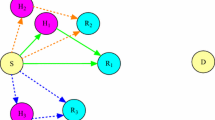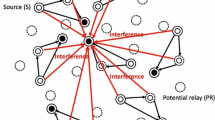Abstract
Cooperative relaying techniques are known to provide spatial diversity for wireless fading channels. In contrast to non-cooperative transmission (direct transmission), they increase link reliability, provide higher capacity, reduce transmit power, and extend transmission range. Mostly the gains of cooperative relaying are shown for single flow scenarios in the absence of inter-flow interference. In this paper we study the effect of inter-flow interference on the capacity of cooperative networks in multi-hop multi-flow settings. We used the conflict graph to model the interference and find the additional constraints introduced due to cooperative transmission by using the concept of cliques on the conflict graph, which can be used to capture the interference relation among links. We formulated the multi-commodity flow problem for network capacity using linear programming, and employed a clique based analysis of the conflict graph to compute interference constraints. It is observed that the throughput drops significantly when cooperative transmissions are used in the network. We also found that the hop counts increase when cooperative links are used that is due to avoiding interfering links, which results in losing the benefits of shortest-path routing.














Similar content being viewed by others
Notes
In this work we are interested on the total capacity, considering the fairness issue presented in some literature that seeks to maximize the total throughput of the network and at least some amount of throughput can be ensured for each commodity.
We mean by cooperative zone here is a group of three nodes such that creating a cooperative link between any pair by using the third node as a relay.
References
Jain, K., Padhye, J., Padmanabhan, V., & Qiu, L. (2003). Impact of interference on multi-hop wireless network performance. Proceedings of ACM Mobile Computing and Networking.
Zhu, Y., & Zheng, H. (2008). Understanding the impact of interference on collaborative relays. IEEE Transactions on Mobile Computing., 7, 724–736.
Sepko, B.J., & Lee, W. (2008). A study on effect of interference in cooperative communication. In Proceedings of IEEE Symposium on Radio and Wireless (pp. 651–654).
Zanella, A., & Masini, B. M. (2011). The impact of relay selection strategies on the amount of interference in ad hoc wireless networks. In IEEE 73rd Vehicular Technology Conference (VTC Spring)(pp. 1–6).
Shila, D. M., Cheng, Y., & Anjali, T. (2010). Capacity of cooperative wireless networks using multiple channels. IEEE International Conference on Communications (ICC) (pp. 1–5).
Zhou, Y., & Zhuang, W. (2013). Beneficial cooperation radio in multi-hop wireless ad hoc networks. In Proceedings on IEEE International Conference on computer Communications.
Laneman, J., Wornell, G., & Tse, D. (2004). Cooperative diversity in wireless networks: Efficient protocols and outage behavior. IEEE Transactions on Information Theory, 50, 3062–3080.
IMB. Ilog cplex. http://www.ilog.com/products/cplex/.
Skiena, S. S. (1997). Agorithm design manual. Berlin: Springer.
Coen, B., & Joep, K. (1973). Finding all cliques of an undirected graph. Communications of the ACM, 16, 575–577.
Cazals, F., & Karande, C. (2008). A note on the problem of reporting maximal cliques. Theoretical Computer Science (Elsevier), 407, 564–568.
Author information
Authors and Affiliations
Corresponding author
Rights and permissions
About this article
Cite this article
Abdulhadi, S., Jaseemuddin, M. & Anpalagan, A. On the Throughput Capacity of Cooperative Multi-hop Wireless Ad hoc Networks with Multi-flow. Wireless Pers Commun 79, 629–646 (2014). https://doi.org/10.1007/s11277-014-1877-x
Published:
Issue Date:
DOI: https://doi.org/10.1007/s11277-014-1877-x




